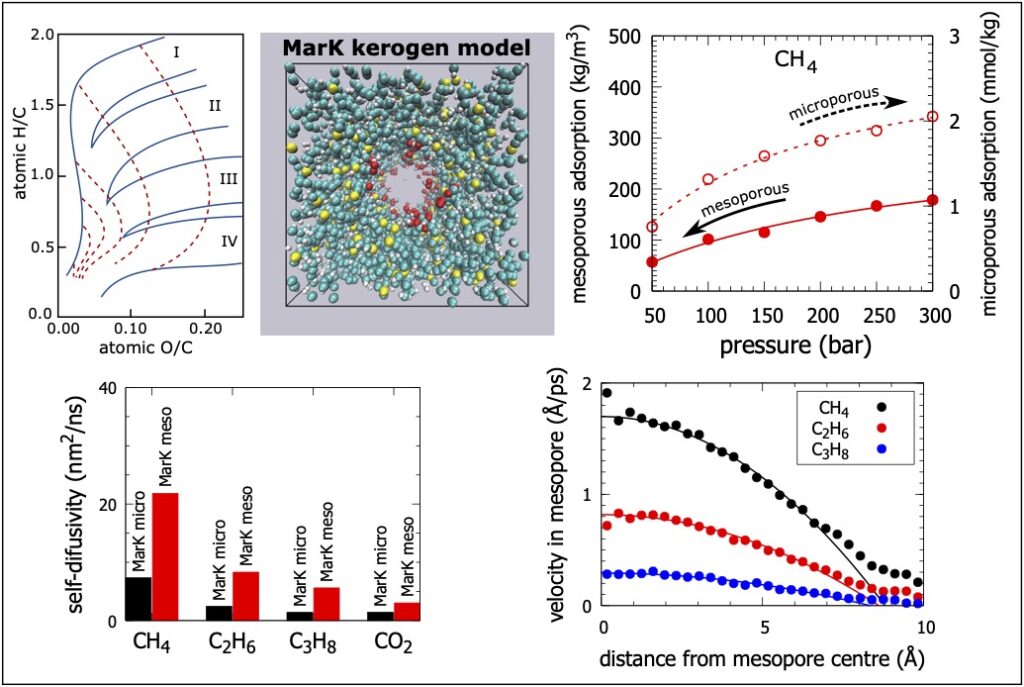Adsorption, diffusion, and transport of C1 to C3 alkanes and carbon dioxide in dual-porosity kerogens: Insights from molecular simulations
 Organic-shale formations are unconventional gas reservoirs with broad pore size distributions. Shale consists of two distinct components: organic matter and clay minerals. The size of pores in the organic matter is mostly concentrated at less than six nanometres and these micropores, and small mesopores provide the majority of adsorption surface area and gas storage volume. In these nanometre-sized pores, the geofluid behaviour becomes significantly different from the bulk behaviour due to the strong solid-fluid interactions and other confinement effects. Understanding the properties of fluids such as methane, ethane, propane and carbon dioxide in narrow shale pores is critical for identifying ways to deploy shale gas technology with reduced environmental impact. Specifically, methane is a proxy of the shale gas and ethane, and propane are minor shale-gas components. Further, carbon dioxide is used for the enhanced shale-gas recovery. We employ molecular-level simulations to explore adsorption, diffusion, and transport of methane, ethane, propane and carbon dioxide in realistic models of organic-shale materials at a representative shale-reservoir temperature and pressures. We first use Hybrid Reverse Monte Carlo with experimental pair distribution functions to build dual-porosity kerogen models corresponding to an immature marine kerogen from the Eagle Ford Play and a mature marine kerogen from the clay-rich Marcellus Play. We then employ Grand Canonical Monte Carlo simulations to study the fluid adsorption in the porous kerogen structures. We complete the adsorption studies by simulating the self-diffusivity, collective diffusivity, and transport diffusivity of the adsorbed fluid molecules in the shale kerogens using equilibrium and non-equilibrium molecular dynamics.
Organic-shale formations are unconventional gas reservoirs with broad pore size distributions. Shale consists of two distinct components: organic matter and clay minerals. The size of pores in the organic matter is mostly concentrated at less than six nanometres and these micropores, and small mesopores provide the majority of adsorption surface area and gas storage volume. In these nanometre-sized pores, the geofluid behaviour becomes significantly different from the bulk behaviour due to the strong solid-fluid interactions and other confinement effects. Understanding the properties of fluids such as methane, ethane, propane and carbon dioxide in narrow shale pores is critical for identifying ways to deploy shale gas technology with reduced environmental impact. Specifically, methane is a proxy of the shale gas and ethane, and propane are minor shale-gas components. Further, carbon dioxide is used for the enhanced shale-gas recovery. We employ molecular-level simulations to explore adsorption, diffusion, and transport of methane, ethane, propane and carbon dioxide in realistic models of organic-shale materials at a representative shale-reservoir temperature and pressures. We first use Hybrid Reverse Monte Carlo with experimental pair distribution functions to build dual-porosity kerogen models corresponding to an immature marine kerogen from the Eagle Ford Play and a mature marine kerogen from the clay-rich Marcellus Play. We then employ Grand Canonical Monte Carlo simulations to study the fluid adsorption in the porous kerogen structures. We complete the adsorption studies by simulating the self-diffusivity, collective diffusivity, and transport diffusivity of the adsorbed fluid molecules in the shale kerogens using equilibrium and non-equilibrium molecular dynamics.
- E. Rezlerová, S. K. Jain, M. Lísal, Adsorption, diffusion, and transport of C1 to C3 alkanes and carbon dioxide in dual-porosity kerogens: Insights from molecular simulations, Energy Fuels 37, 492-508, 2023. DOI